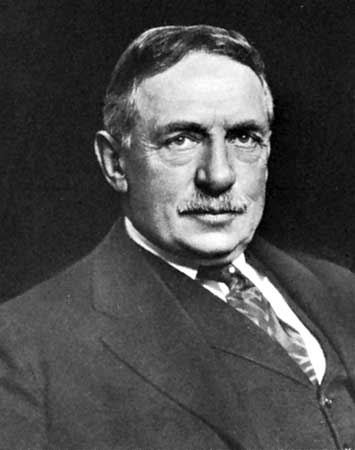Osborn, Henry Fairfield
American paleontologist
born Aug. 8, 1857, Fairfield, Conn., U.S.
died Nov. 6, 1935, Garrison, N.Y.
 American paleontologist and museum administrator who greatly influenced the art of museum display and the education of paleontologists in the United States and Great Britain.
American paleontologist and museum administrator who greatly influenced the art of museum display and the education of paleontologists in the United States and Great Britain.At Princeton University, Osborn conducted studies of brain anatomy while serving as assistant professor of natural sciences (1881–83) and professor of comparative anatomy (1883–90). He spent the greater part of his career in New York City, as professor of biology (1891–96) and zoology (1896–1935) at Columbia University, but devoted most of his attention to the city's American Museum of Natural History. As curator of the department of mammalian (later changed to vertebrate) paleontology (1891–1910) and president of the museum (1908–35), Osborn accumulated one of the world's finest vertebrate-fossil collections. He introduced a highly successful instructional approach to museum display and was also an effective popularizer of paleontology.
Osborn proposed the valuable concept of adaptive radiation, postulating that a primitive plant or animal in many cases evolves into several species by scattering over a large land area and adapting to different ecological niches. Osborn also served as vertebrate paleontologist (1900–24) and senior geologist (1924–35) with the U.S. Geological Survey. His works include From the Greeks to Darwin (1894), The Age of Mammals (1910), and Origin and Evolution of Life (1917).
- Manuel García
- Manuel González
- Manuel Gutiérrez Nájera
- Manuel Gálvez
- Manuel I
- Manuel I Comnenus
- Manuel II
- Manuel II Palaeologus
- Manueline
- Manuelito
- Manuel José Quintana
- Manuel Lisa
- Manuel Lopes
- Manuel (Luis) Quezon (y Molina)
- Manuel Machado
- Manuel Maria Barbosa du Bocage
- Manuel Montt
- Manuel Moschopoulos
- Manuel Mujica Láinez
- Manuel, Niklaus
- Manuel Noriega
- Manuel Pavía y Lacy
- Manuel Pavía y Rodríguez de Alburquerque
- Manuel Puig
- Manuel Rojas